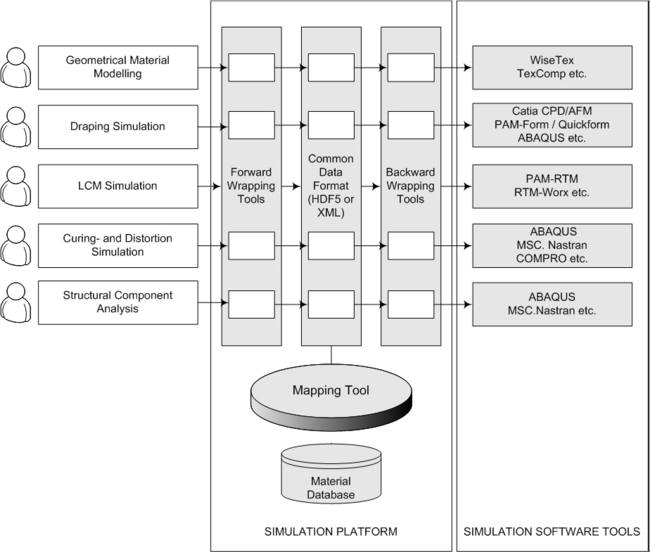MAI Design – Fiber- and Production-Ready Design and Dimensioning of Components from High Performance Composite Materials
By means of process simulation, the influence of the raw material and the process on the performance on the finished part can be determined. Additionally, feasibility, quality and productivity can be assesed in an early design phase. In the project MAI Design, the separate steps of process simulation were linked with each other by defined interfaces so that a holistic view on the production process was achieved. Properties caused by the production process can now be taken into account for structural analysis of a component’s stiffness and strength.
Project Partners
Airbus Group Innovations, Aerostruktur Faserverbundtechnik GmbH, Audi AG, Automation W+R GmbH, BMW AG, CADCON Ingenieurgesellschaft mbH & Co. KG, Airbus Helicopters Deutschland GmbH, ESI Engineering System International GmbH, KSB AG, Premium Aerotec GmbH, Roding Automobile GmbH, Voith Composites GmbH & Co. KG, Deutsches Zentrum für Luft- und Raumfahrt e. V., Hochschule für angewandte Wissenschaften Augsburg, Fraunhofer-Einrichtung für Gießerei-, Composite- und Verarbeitungstechnik IGCV, Universität der Bundeswehr München, TU München – Lehrstuhl für Leichtbau
Duration
01.07.2012 – 30.06.2015
Funding authority
German Federal Ministry of Education and Research
Motivation
Lightweight design becomes increasingly important in the aviation and automotive industry but also in general mechanical engineering. Fiber composite materials from carbon fiber enable a significant weight reduction (factor 4-5 compared to steel). Currently, the production of fiber reinforced structures often involves a considerable amount of manual work. This leads to long processing times and reduced process stability. Therefore, the goal is to achieve a transition to partly or even fully automated production technologies. Due to the commencing mass production of fiber reinforced structures, production-ready designs are brought to the fore. An important prerequisite for this production-ready design is the integral consideration of the whole manufacturing process chain. A consistent simulation chain for production processes of fiber composite materials was however not state of the art. This was why the integration into a single simulation chain and platform was key of this project. In the sense of a holistic validation philosophy, the dimensioning of a component shall also be integrated into this simulation chain. Thus, influences of the production process can directly be considered in the dimensioning of a component.


Method
Process simulation shall significantly shape the development of automated production processes for fiber composite structures. In the project MAI Design, the following manufacturing steps were simulated:
- The placement and forming process of semi-finished products, e.g. dry non-crimp fabrics
- The subsequent infiltration process with resin, which may be injected at up to 100 bar in a closed mold
- The curing process, which takes place at temperatures of up to 180 °C and which can lead to residual stresses and process induced deformations after cooling to room temperature.
The linkage between these seperate steps of process simulation, hence the integration into a single simulation chain and platform, was key of this project. In the sense of a holistic validation philosophy, this platform was extended to the dimensioning of a component. Thus, influences of the production process can now directly be accounted for in the design phase of the component. Furthermore, with regard to an increasing mass production of composite structures, a new approach for the choice of fiber- and production-ready composite designs was also developed. The simulative prediction of the forming process of themolastic laminates was carried out by means of the FE software PAM-Form (ESI Group). Due to difficulties with classic test benches, new methods for material characterisation were developed. All necessary modes of deformation were characterised under forming process conditions using these new methods. Following the material characterization, a new version of the material data set MAT140, which was used for modelling the semi-finished product, was calibrated. The new linked simulation approach was validated by comparison to optical measurements (fiber orientation) on a generic component.
Publications
Mayer, N.; Van Den Broucke, B.; Prowe, J.; Havar, T.; Hinterhölzl, R.: Finite element mapping for incompatible FE meshes of composite structures. Advances in Engineering Software 99, 2016, 81-8
Margossian, A.; Bel, S.; Hinterhölzl, R.: Bending characterisation of a molten unidirectional carbon fibre reinforced thermoplastic composite using a Dynamic Mechanical Analysis system. Composites Part A: Applied Science and Manufacturing 77, 2015, 154-163
Margossian, A.; Bel, S.; Avila Gray, L.; Hinterhölzl, R.: Characterisation of tensile properties perpendicular to fibre direction of a unidirectional thermoplastic composite using a Dynamic Mechanical Analysis system. ESAFORM 2015 - 18th International ESAFORM Conference on Material Forming, 2015
Margossian, A.; Ding, M.; Avila Gray, L.; Bel, S.; Hinterhölzl, R.: Flexural characterisation of unidirectional thermoplastic tapes using a Dynamic Mechanical Analysis system. ECCM16 - 16th European Conference on Composite Materials, 2014
Margossian, A.; Bel, S.; Balvers, J.M.; Leutz, D.; Freitas, R.; Hinterhölzl, R.: Finite element forming simulation of locally stitched non-crimp fabrics. Composites Part A: Applied Science and Manufacturing 61, 2014, 152-162
Hartmann, M.; Hinterhölzl, R.: Process Induced Deformations - A study on sandwich panels. SAMPE Seattle 2014, 2014
Hartmann, M.; Strebinger, M.; Hinterhölzl, R.: An approach towards a basic materials characterization for the simulation of Process Induced Deformations. ICCM19 - 19th International Conference on Composite Materials, 2013
Acknowledgement
The chair thankfully acknowledges the funding of the project “Faser- und fertigungsgerechte Bauweisen und Auslegung von Bauteilen aus Hochleistungsverbundwerkstoffen – MAI Design” provided by the German Federal Ministry of Education and Research under the leading edge cluster MAI Carbon (funding code: 03MAI02R).



Contact Persons
Dr.-Ing. Swen Zaremba
Final Report
External link (pdf)